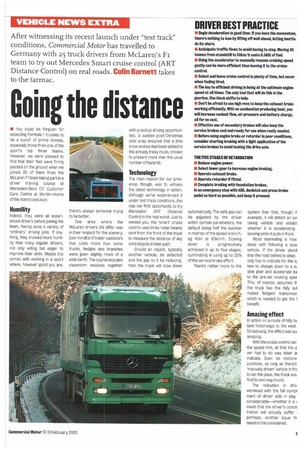Going the distance
Page 15

If you've noticed an error in this article please click here to report it so we can fix it.
• You could be forgiven for expecting Formula 1 truckles to be a bunch of prima donnas, especially those from one of the sport's top three teams. However, we were pleased to find that their feet were firmly planted on the ground when we joined 25 of them from the McLaren Fl team taking part in a driver training course at Mercedes-Benz CV Customer Care Centre at Worth—home of the Actros and Axor.
Humility
Indeed, they were all experienced drivers before joining the team, having done a variety of 'ordinary' driving jobs. If anything, they showed more humility than many regular drivers, not only willing but eager to improve their skills. Maybe this comes with working in a sport where, however good you are, there's always someone trying to be better.
One area where the McLaren drivers did differ was in their respect for the scenery Ever mindful of trailer paintwork that costs more than some trucks, hedges and branches were given slightly more of a wide berth. The course included classroom sessions together with practical driving opportunities. A sudden post-Christmas cold snap ensured that a little snow and ice had been added to the already tricky route, chosen to present more than the usual number of hazards.
Technology
The main reason for our presence, though, was to witness the latest technology in action. Although we've experienced it under test track conditions, this was our first opportunity to try Mercedes' ART Distance Control in the real world. Just to remind you, this 'smart' cruise control uses three radar beams sent from the front of the truck to measure the distance of any solid objects in their path.
Should an object, typically another vehicle, be detected and the gap to it be reducing, then the truck will slow down automatically. The safe gap can be adjusted by the driver within certain parameters, the default being half the number in metres of the speed in km/h, eg 40m at 80km/h. Slowing down is progressively achieved in up to five stages, culminating in using up to 20% of the service brake effort.
There's rather more to the system than that, though. F example, it will detect an ovi taking vehicle and establi whether it is accelerating slowing when it pulls in front.
Most interesting is how deals with following a slow vehicle. If the driver decid that the road behind is clear, only has to indicate for the s), tom to change down to a si able gear and accelerate ba to the pre-set cruising spec This, of course, assumes if the truck has the fully aid mated Telligent transmissi which is needed to get the 1 benefit.
Amazing effect
In action on a route of hilly tin lane motorways to the west Strasbourg, the effect was qui amazing.
With the cruise control set the speed limit, all that the d ver had to do was steer al indicate. Even on motorw junctions, as long as there's 'manually driven' vehicle in fro to set the pace, the truck wot find its own way round.
The reduction in driv workload with the full compl ment of driver aids in play considerable—whether it is : much that the driver's conce tration will actually suffer perhaps, another issue th needs to be considered.




































































































































































